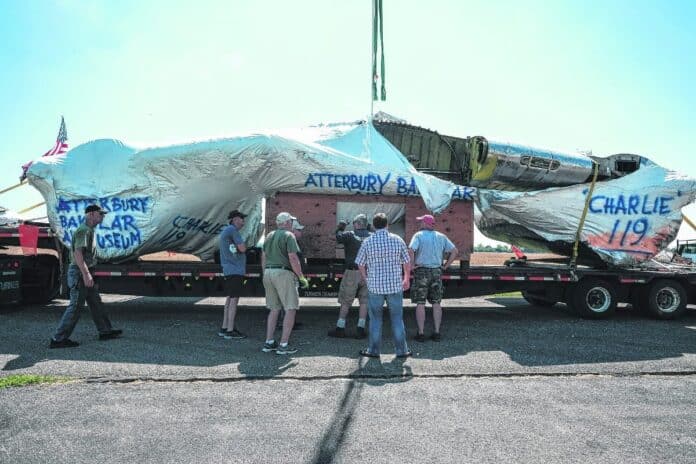
The final pieces of a C-119 "Flying Boxcar" aircraft purchased by the Atterbury-Bakalar Air Museum have made it to Columbus, the culmination of months of planning and several trips to Wyoming to pick up parts of the disassembled plane.
The 40,000-pound plane, which is not airworthy, was taken apart several months ago at an airport in Greybull, Wyoming, where the aircraft’s parts were loaded on to trucks and driven 1,460 miles to the Columbus Municipal Airport.
The final parts of the disassembled aircraft that arrived at Columbus Municipal Airport on Thursday include the plane’s propeller systems and the wing box, a centralized part of the plane that connects to several key parts of the aircraft, including the wings and fuselage, among others.
Looking from above, the wing box is around 38-feet long and 21-feet wide, weighing around 10,000 pounds. The propellers are 15 feet in diameter.
[sc:text-divider text-divider-title=”Story continues below gallery” ]Click here to purchase photos from this gallery
Previous shipments of parts, including the tail booms engines, outer wings and the iconic fuselage that gave the aircraft its nickname, arrived in March.
“It feels really good,” said Skip Taylor, a museum member who is leading the C-119 project. “We’re happy, and it’s going to be even better when we make progress on putting it back together. This concludes phase 1. Phase 1 was to get it, get it apart and get it here, and we got that done, so we’re happy about that.”
On Thursday morning, the parts arrived a on trailer with a police escort after a nearly nine-day hold up in Iowa before officials in that state issued a permit to allow the parts to be driven across the state.
Columbus-based Force Construction provided the project’s volunteers with a crane and a crane operator at no charge to help them unload the 10,000-pound wing box and place it inside a facility at Columbus Municipal Airport, Taylor said.
The aircraft will be reassembled there, restored and put on public display just south of the McDonnell Douglas F-4 Phantom II aircraft now on display.
Next, volunteers will continue cleaning parts, “finding all the bits and pieces” and then start reassembling the major pieces of the aircraft, including putting the wing box and fuselage back together and re-attaching the wings, Taylor said.
The goal is to have the plane in its exhibit space in the fall, though it may take a couple more years to finish restorations, Taylor said.
The magnitude of the project had been difficult to fully appreciate until the pieces of the aircraft started arriving and volunteers started looking at putting them back together, Taylor said.
It’s hard to say just how many thousands of pieces the aircraft has, but Taylor said there is a roughly 1,200-page list of parts.
“Think about that – 1,200 pages – and something on the order of 8- or 9-point font,” Taylor said. “You can just imagine how many parts there are.”
The C-119, also known as the “Flying Boxcar” due to the unusual shape of its fuselage, was in service with the U.S. Air Force from 1947 to 1972 and was designed to carry cargo, personnel, litter patients and mechanized equipment. The aircraft was also used to drop cargo and troops using parachutes, according to the Strategic Air Command and Aerospace Museum.
The aircraft, when assembled, is about 86-feet long, has a 110-foot wingspan and is 27-feet tall at the tail. The Flying Boxcars were powered by two Wright R-3350 Duplex Cyclone radial engines, each with 3,500 horsepower, and could reach a maximum speed of 296 miles per hour.
The U.S. Air Force extensively used C-119s during the Korean War from 1950 to 1953.
Retired C-119s were also used as air tankers to fight wildfires in the United States.
The particular C-119 purchased by the museum was built in Hagerstown, Maryland, for the Canadian Air Force, Taylor said. The aircraft was later acquired by Hawkins & Powers and used to fight forest fires. Its last known flight was in 1990.
The Flying Boxcars are of particular historical significance to Columbus, according to museum volunteers. Here, the pilots referred to them as the “Dollar Nineteens,” according to museum records.
From 1957 to 1969, 36 C-119s for the 434th Troop Carrier Wing were stationed at Bakalar Air Force Base, which is now Columbus Municipal Airport. The C-119s were a staple in Columbus, flown out of the base longer than any other aircraft.
Manufacturers Fairchild and Kaiser built 1,151 of the C-119s from 1949 to 1955. However, only around 40 Flying Boxcars are still left today, most of them in museums across the country or in a scrap yard.
The Atterbury-Bakalar Air Museum purchased the plane for $15,000 in May 2019.
That same month, the museum launched a crowdfunding campaign sponsored by the Indiana Housing and Community Development Authority, and raised $50,034 to disassemble and transport the plane to Columbus, according to the campaign’s website.
The project also received a $50,000 matching grant from the Indiana Housing and Community Development Authority’s CreatINg Places program, the state’s crowdfunding grant program.
[sc:pullout-title pullout-title=”About the project” ][sc:pullout-text-begin]
Visit atterburybakalarairmuseum.org/project-charlie-119.html for more information about the project.
[sc:pullout-text-end][sc:pullout-title pullout-title=”For more photos” ][sc:pullout-text-begin]
Visit therepublic.com for more photos of the "Flying Boxcar."
[sc:pullout-text-end]




